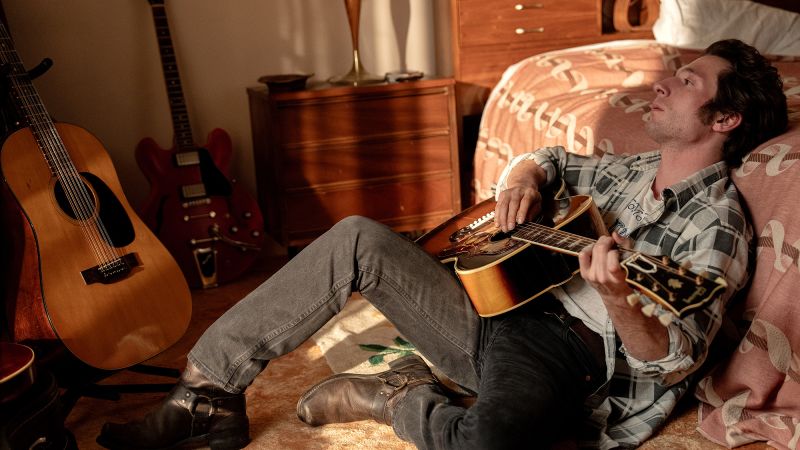Copyright Cable News Network

It is fall 1981 and a 31-year-old Bruce Springsteen has just wrapped a wildly successful tour for his latest album, “The River.” But instead of returning to the studio to produce new songs — as was the preference of his label Columbia Records — the musician retreated to a quiet house in Colts Neck, New Jersey, near where he grew up, to rest and recover. There, intentionally isolated, but unintentionally reliving childhood trauma and subsequent depression, Springsteen ended up self-recording 10 songs that would form his seminal low-fi album “Nebraska.” This definitive period in the rock star’s life is the background to “Springsteen: Deliver Me From Nowhere,” a new movie directed by filmmaker Scott Cooper, which stars “The Bear’s” Jeremy Allen White as a convincing Springsteen and Jeremy Strong, of “Succession” fame, portraying his longtime manager and friend Jon Landau. The stylish biopic charts the tumultuous times of Springsteen’s early life and their influence on his music. It doesn’t, however, shy away from examining the singer’s often painful oscillation between indefatigable global rock god and fragile human, and his search for authenticity and belonging when separated from his working class roots. It’s a dichotomy also conveyed through Springsteen’s clothing — his eminently familiar blue collar ‘Americana’ uniform of Levi’s jeans, leather jackets with the collar popped, plaid flannels, white tanks and boots, which the now 76-year-old can still be seen in today. In a video interview with CNN, the movie’s costume director Kasia Walicka Maimone (whose CV includes “The Gilded Age,” “Moonrise Kingdom,” and “Capote”) said that she and her team did a lot of prep before their first meeting with Springsteen, who was involved in the production. “Bruce was pretty involved and it was amazing to spend time with him because, of course, he’s a legend. Many of us on the movie were already big fans,” she said. “The way he can communicate emotion and tell stories that resonate is, to me, like religion. But there was definitely a moment to put the awe aside and say, ‘OK, now we have to become collaborators’.” But, said Maimone, Springsteen eminently respected the creative process. “What became clear even in the first conversation I had with Bruce was that, even though he was very well photographed at that specific time (1981-1982), there were pieces he loved more than others — his everyday wear was different to items that were used for photoshoots or concerts. We were continuously breaking through the levels of intimacy and discovering those super private moments and pieces that were significant, that meant a lot to him… Those are what we tried to reflect in the movie, so Bruce’s input was key.” Indeed, some of the garments White wears in the film are borrowed from Springsteen’s actual wardrobe, including a Triumph Motorcycles T-shirt and an original blue and white plaid shirt from the early 1980s that the star had often worn. “That was one of Bruce’s beloved pieces, and it was very delicate,” Maimone said. “We knew that it might shred during filming, not least because Jeremy Allen White and Bruce Springsteen are not the same size. But we all wanted so much to use it in an emotional scene with Bruce and his father, and Bruce felt that if the piece were to shred, that particular scene would be the most beautiful moment for it to go.” The personal is political Very few rock stars’ wardrobes stand the test of time. Even fewer keep that up over a 50-year career. Yet 45 years on from “Nebraska,” the one they call “The Boss” remains one of the world’s greatest music icons with an almost unchanged personal style, having sold more than 140 million records, winning 20 Grammy awards and earning a billion-dollar fortune along the way. Part of Springsteen’s visual legend comes from the fact that everything he wears — the denim, the leather jackets, the flannel shirts — is easily accessible to his fans. “Around that time (the early 1980s), Bruce Springsteen was universally appealing. Men wanted to be him and women wanted to date him,” said Patricia Mears, deputy director of The Museum at the Fashion Institute of Technology in New York, in a phone call. “He’s not consciously stylish, but he is authentically working class, which is where the bulk of his audience is from too. His clothing choices embody the image of a man who does ‘a proper day’s work,’ which is an idea that would appeal to his fanbase.” But it’s a look also tied up in personal politics and patriotism — take, for instance, the worn Levis, faded baseball cap and overall red, white and blue theme on the cover of 1984’s “Born In The USA” album. Springsteen has also stayed true to his left-leaning roots despite global fame. “He supports workers, never comes across as being elitist and threads a very narrow channel of managing to still appeal to his working class base — many of whom have probably supported Donald Trump — without doing the same,” added Mears. Nancy Deihl, a fashion historian and chair of New York University’s art department, who grew up in New Jersey, said Springsteen and his style was known to her and her friends before he was known to the rest of the world. “I recall a multi-generational conversation held over a holiday dinner,” Deihl explained in a phone call. “The parents all said Bruce Springsteen’s clothes made him look so grubby. They were used to polished performers like Frank Sinatra or Tom Jones. They read his working class style — the bandanas, the jeans — as alternative, as his ‘having not tried hard enough’.” However, Deihl sees Springsteen’s workwear style as “a signifier of socio-economics; basic, usable items in fabrics such as denim and flannel,” she explained. “These associations not only echo the messaging of his music, they don’t date.” How he wears what he wears Springsteen was also a harbinger of the rise of workwear within fashion more broadly, said Mears. “Today, workwear is commonly repurposed as fashion — think Carhartt and Dickies — and performative hipsters channel that authenticity with, sometimes, limited success. But the way Springsteen did it is not hackneyed. His connection to American roots and American roots music authenticated him to dress in this way.” To create a believable image in the film, it was important for Maimone to channel how Springsteen wears clothes as much as source the correct garments themselves. “Bruce has fantastic style naturally, but he also gives clothes charisma,” she said. “He wore utilitarian workwear pieces in a very specific way — the super tight, high-waisted jeans, Cuban-heeled boots, leather jackets that fit exactly… Bruce’s proportions are perfectly balanced and he wears pieces with a level of ease and confidence. The same item on somebody else might look very different. My job was to capture that ease and confidence.” Maimone said she and the costuming team spent a long time with White when he was “absorbing” Springsteen, referencing old photographs, period vintage pieces they’d spent months sourcing and the insights from Springsteen himself. “Jeremy was becoming, you know, the channeler of Bruce Springsteen’s spirit,” said Maimone. “He did it so beautifully and he became him in the most phenomenal way. And it translated to the way he wore those pieces. We sometimes liken a movie’s clothing to another ‘skin,’ another level of the character. And Jeremy ‘absorbed’ the skin of Bruce Springsteen.” The man himself agrees. “Jeremy didn’t try to do any sort of impression. He simply inhabited my inner life,” said Springsteen in the movie’s notes. “The camera picked up on those complexities and that was essential in making the character completely believable. That’s where he’s performing his magic from, and he just did a beautiful job of it.”



